
Powys is a county and preserved county in Wales. It borders Gwynedd, Denbighshire, and Wrexham to the north; the English ceremonial counties of Shropshire and Herefordshire to the east; Monmouthshire, Blaenau Gwent, Merthyr Tydfil, Caerphilly, Rhondda Cynon Taf, and Neath Port Talbot to the south; and Carmarthenshire and Ceredigion to the west. The largest settlement is Newtown, and the administrative centre is Llandrindod Wells.

The River Monnow marks the England–Wales border for much of its 42 miles (68 km) length. After flowing through southwest Herefordshire, England, and eastern Monmouthshire, Wales, its confluence with the River Wye is approximately 1⁄3 mile (0.54 km) south of Monmouth.
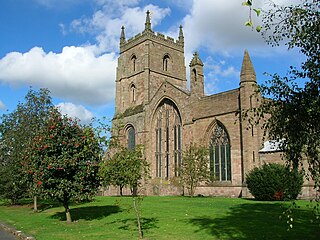
Leominster is a market town in Herefordshire, England; it is located at the confluence of the River Lugg and its tributary the River Kenwater. The town is 12 miles north of Hereford and 7 miles south of Ludlow in Shropshire. With a population of 11,700, Leominster is the largest of the five towns in the county; the others being Ross-on-Wye, Ledbury, Bromyard and Kington.

The A44 is a major road in the United Kingdom that runs from Oxford in southern England to Aberystwyth in west Wales.

Kington is a market town, electoral ward and civil parish in Herefordshire, England. The ward had a population of 3,240, while the 2011 Census registered a population of 2,626.

Herefordshire is a ceremonial county in the West Midlands of England. It is bordered by Gloucestershire to the south-east, Worcestershire to the east, Shropshire to the north and the Welsh counties of Monmouthshire and Powys to the west. The city of Hereford is the largest settlement and the county town.

The River Lugg rises near Llangynllo in Radnorshire, Wales. It flows through the border town of Presteigne and then through Herefordshire, England, where it meets its main tributary, the River Arrow, to the south of Leominster. It flows into the River Wye downstream of Hereford at Mordiford, around 63 miles (101 km) from its source. Its name comes from a Welsh root, and means "bright stream".

Pembridge is a village and civil parish in the Arrow valley in Herefordshire, England. The village is on the A44 road about 6 miles (10 km) east of Kington and 7 miles (11 km) west of Leominster. The civil parish includes the hamlets of Bearwood, Lower Bearwood, Lower Broxwood, Marston, Moorcot and Weston. The 2011 Census recorded the parish population as 1,056.

Combe Moor, also known as Coombes Moor, is a linear hamlet in the civil parish of Byton in Herefordshire, England, to the south-east of the Welsh town of Presteigne, near the border with Wales, and 17 miles (27 km) north-west from the county town of Hereford.

The River Ely is in South Wales flowing generally southeast, from Tonyrefail to Cardiff.
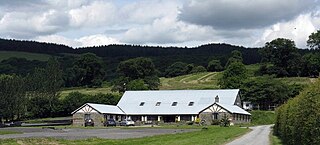
Kinsham is a civil parish which lies in the wooded hills of Herefordshire, England in the Marches near to the border with Wales, about 3 miles (5 km) east of the Welsh town of Presteigne. The parish has two small settlements, Upper Kinsham and Lower Kinsham, in the east overlooking the valley of the River Lugg, which marks the parish boundary.
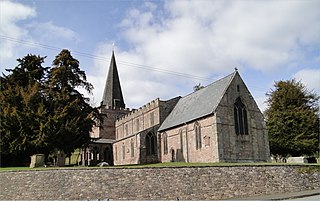
Dilwyn is a village in Herefordshire, England located about 18 km (11 mi) from the city of Hereford and 9 km (6 mi) from its nearest town, Leominster. It is situated on the northern edge of a broad valley that stretches from the River Wye through to Leominster. Running through the valley, south of the village, is the Stretford Brook whilst to the north are the rivers Arrow and Lugg.

The Marches Way is a partially waymarked long-distance footpath in the United Kingdom. It runs for 351 kilometres (218 mi) through the Welsh–English borderlands, traditionally known as the Welsh Marches, and links the cities of Chester in the north and Cardiff in the south.

The Herefordshire Trail is a long distance footpath in Herefordshire, England.
Ivington is a village in the county of Herefordshire, England, approximately 13 miles (21 km) north of Hereford. It is about 2 miles (3 km) south-west of its post town Leominster. The population as of the 2011 census was included within Leominster. Ivington has a small church dedicated to St. John, and a Church of England Primary School.
Leominster and Kington Railway was one of four branches which served the Welsh Marches border town of Kington, Herefordshire.
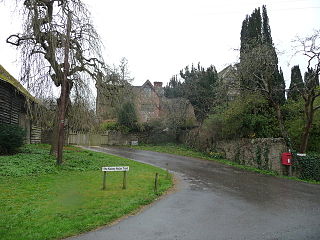
Rodd, Nash and Little Brampton is a civil parish in the county of Herefordshire, England, and is 18 miles (29 km) north-west from the city and county town of Hereford. The parish borders Powys in Wales at its north-west. Within the parish is the final home and studio of the 20th-century Australian artist Sydney Nolan.

Staunton on Arrow is a village and civil parish in the county of Herefordshire, England. The village is 17 miles (27 km) north-west of Hereford and 8 miles (13 km) to the west of Leominster. Within the parish is the site of the Iron Age hill fort of Wapley Hill.
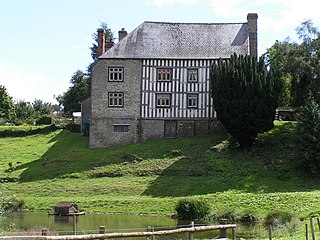
Kington Rural is a civil parish in west Herefordshire, England, and is approximately 17 miles (30 km) north-west from the city and county town of Hereford. The parish borders Wales at the west, and contains the hamlets and small settlements of Upper Hergest, Lower Hergest, Chickward, Bredward, and Kingswood at the south, and Bradnor Green and Rushok at the north. The nearest town is the market town of Kington which, with its parish, is to a large extent enclosed by Kington Rural. Significant landmarks of the parish are the Castle Twts motte and bailey earthwork, Hergest Court 15th-century manor house, and Hergest Ridge on the England–Wales border.

















